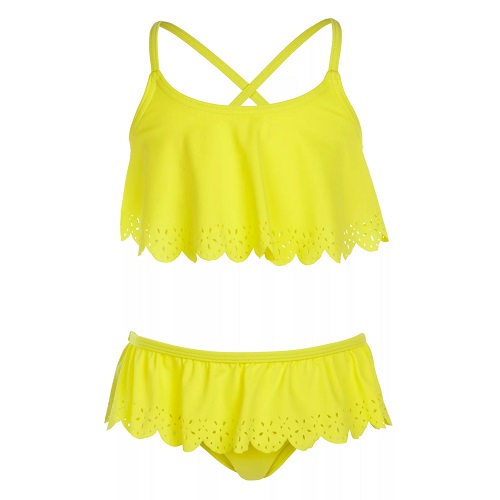Content Menu
● Introduction to Laser Cut Swimwear
● What is Laser Cut Swim Technology?
● Advantages of Laser Cut Swimwear
>> Precision and Intricacy
>> Clean, Durable Edges
>> Customization Potential
>> Speed and Production Efficiency
>> Material Waste Reduction and Sustainability
>> Consistency Across Products
● The Process: How Is Laser Cut Swimwear Made?
>> Video Demonstrations
● Materials for Laser Cut Swimwear
● Practical Design Innovations
● Market Trends and Applications
>> Fashion and Aesthetics
>> Performance and Comfort
● Care and Maintenance
● Benefits of Laser Cut Swimwear
● Challenges and Considerations
● Common Questions and Answers (FAQ)
>> What is laser cut swim?
>> Why choose laser cut swimwear?
>> What fabrics are best for laser cut swimwear?
>> How does laser cut swim differ from traditional methods?
>> Can OEM swim manufacturers in China provide laser cut swimwear?
● Citations
Laser cut swimwear, commonly referred to through the keyword "what is laser cut swim," is revolutionizing the fashion industry by introducing precise, intricate, and durable designs on modern swimsuits using advanced laser technology. This article provides a comprehensive overview of laser cut swimwear, explaining its technology, benefits, processes, material choices, and market trends, tailored for international swimwear brands and wholesalers seeking innovative solutions.[1][2]

Introduction to Laser Cut Swimwear
The question "what is laser cut swim" refers to a highly technical process in which designers use laser beams to cut swimwear fabrics with incredible accuracy and detail. This method differs from conventional cutting, as lasers produce flawless edges and enable intricate patterns, from geometric shapes to custom logos and lace effects, without fraying or imprecision. The swimwear industry rapidly adopted this technique to meet rising demands for customization, style, and performance.[3][4][2]
What is Laser Cut Swim Technology?
Laser cut swimwear utilizes a focused laser beam to slice synthetic fabrics (nylon, spandex, polyester blends) into highly defined shapes and patterns. The process begins with digital design files mapped out on specialized machinery, where lasers follow programmed routes for complex designs, including:[2][3]
- Matrix arrays of holes for ventilation and style
- Sculpted images or logos
- Intricate cutouts for texture and dimensionality[1]
By automatically sealing fabric edges as the laser passes, the technology prevents fraying and ensures longevity in swimwear that faces frequent exposure to water, sunlight, and abrasion.[3][2]
Advantages of Laser Cut Swimwear
Precision and Intricacy
Laser cut swimwear stands out for its exceptional detail and sharpness. Designs such as lace effects, cutout motifs, and complex overlays—previously impractical with scissors or rotary blades—are now achievable with lasers.[2][1]
Clean, Durable Edges
Laser beams cauterize fabric edges, ensuring that cutouts retain their shape and never fray, enhancing both aesthetics and durability.[3][2]
Customization Potential
Brands and private labels use "what is laser cut swim" to create customized looks for each client, leveraging technology for logos, personalized patterns, and even branded effects on the swimsuit surface.[2]
Speed and Production Efficiency
Laser cutting is far faster than traditional methods, reducing manual labor and increasing throughput. Production lines can rapidly switch designs digitally, supporting seasonal fashion cycles and special collections.[5][2]
Material Waste Reduction and Sustainability
By cutting precise shapes, the process minimizes fabric waste, supporting sustainable manufacturing practices and cost efficiency.[2]
Consistency Across Products
The digital nature of laser cut swim ensures every swimsuit in a batch is identical, boosting quality assurance for international buyers.[2]
The Process: How Is Laser Cut Swimwear Made?
Laser cut swimwear production generally follows these steps:[3][2]
1. Digital Design Mapping: Designers create motifs and patterns using software.
2. Fabric Selection: Typically spandex, nylon, polyester, or specialty blends for flexibility and water resistance.
3. Machine Setup: The design file uploads to the laser cutter's control system.
4. Cutting Execution: Lasers move over the fabric, enacting programmed cuts with speed and precision.
5. Quality Control: Cut pieces undergo inspection for edge accuracy, pattern fidelity, and consistency.
6. Assembly: Components are sewn into finished swimwear, potentially including lining, embroidery, or additional decorative treatments.
Video Demonstrations
For an in-depth look at the machinery involved, refer to these process and product videos:
- [Swimwear Laser Cutting Machine | Spandex & Lycra — Vision Laser Demo][6][5]
- [How to Laser Cut Sublimated Sportswear — MimoWork Vision Cutter][7]
- [Laser Cutting in Swimwear Manufacturing — Automated Production Overview][8]
- [How to laser cut a Swimsuit — Step-by-Step Tutorial][9]
These videos illustrate advanced equipment, the seamless cutting of stretch materials, and automation supporting scale production for OEM swim brands.
Materials for Laser Cut Swimwear
The choice of fabric is fundamental for "what is laser cut swim." The most used textiles are:
- Nylon: Lightweight, stretchy, quick-drying, and shape-retentive.
- Spandex/Elastane: Adds superior elasticity and fit, blends smoothly with nylon or polyester.
- Polyester blends: Offer printability and durability.
- Polyurethane: Used for compression and water-resistance.
- Neoprene: Selected for wetsuits, providing insulation.
- Microfiber: Smooth and moisture-wicking, often for cover-ups.[2]
The blend and composition depend on comfort, intended activity (leisure vs. competition), and the desired style.
Practical Design Innovations
Modern "what is laser cut swim" products include:
- High-cut legs for streamlined look
- Deep scooped backs and cap sleeves
- Tone-on-tone embossed logos
- Matrix arrays forming shapes (e.g., dolphins, palm trees, map outlines)
- Color blocked laser cut bikini sets with unique detailing[10][11]
Swimwear manufacturers often use laser cut swim techniques to enable seamless movement from water to land, embracing advanced fabrics and functional design.[10]
Market Trends and Applications
Fashion-forward swimwear brands increasingly market laser cut swim as high-end, exclusive, and trendsetting. From resort wear to competitive suits, the technology appeals to customers seeking unique style and comfort. OEM swim factories in China have embraced laser cut processes to deliver swift, customizable supply for global wholesalers and private labels.[12][13]
Fashion and Aesthetics
Laser cut swimwear is often characterized by its stylish designs, featuring cutouts, patterns, and textures that add a modern touch. Brands are increasingly using laser cutting to create unique pieces that appeal to fashion-forward consumers.
Performance and Comfort
In addition to aesthetics, laser cut swimwear is designed with performance in mind. The precision of the cuts allows for better fit and flexibility, enhancing the swimmer's experience. The seamless edges reduce chafing and discomfort, making these swimsuits ideal for both casual beachgoers and competitive athletes.
Care and Maintenance
To maximize the lifespan of "what is laser cut swim," users should:
- Rinse in non-chlorinated water immediately after use.
- Avoid prolonged exposure to direct sunlight or wet storage.
- Wash with mild detergents; air dry away from heat.
- Never machine dry, bleach, or iron.[10]
Benefits of Laser Cut Swimwear
1. Durability: The sealed edges created by laser cutting enhance the durability of swimwear, making it resistant to wear and tear.
2. Unique Designs: Brands can create distinctive styles that set them apart from competitors, appealing to a broader audience.
3. Sustainability: Laser cutting can reduce fabric waste, as it allows for more efficient use of materials.
Challenges and Considerations
While laser cutting offers numerous benefits, there are also challenges to consider. The initial investment in laser cutting technology can be significant, and not all fabrics are suitable for this method. Additionally, brands must ensure that their designs are optimized for laser cutting to avoid complications during production.
Common Questions and Answers (FAQ)
What is laser cut swim?
Laser cut swimwear refers to swimsuits manufactured using precision laser technology to create intricate designs, motifs, and customizations on stretch fabrics, resulting in stylish, durable, and modern swimwear.[1][3][2]
Why choose laser cut swimwear?
This technique brings unmatched precision and customizability, clean edges, less waste, and rapid production—qualities especially appealing for international swimwear brands and private labels.[2]
What fabrics are best for laser cut swimwear?
Typical materials include nylon, spandex, polyester blends, and sometimes specialized polyurethanes or neoprene, chosen for stretch, durability, and printability.[2]
How does laser cut swim differ from traditional methods?
Laser cut swimwear excels in producing intricate patterns and shapes without frayed edges, something nearly impossible with scissors or rotary blades. It also streamlines production and ensures repeatability.[3][2]
Can OEM swim manufacturers in China provide laser cut swimwear?
Yes, many swimwear factories in China, such as those serving international brands and wholesalers, offer OEM laser cut swimwear, enabling clients to specify unique brand motifs and designs.[1][2]
Citations
[1](https://www.lasercutfabric.com/swim-suits/)
[2](https://www.mimowork.com/laser-cut-swimsuit/)
[3](https://www.mereton.com.au/blog/everything-there-is-to-know-about-laser-fabric-cutting)
[4](https://www.engadget.com/2014-06-17-laser-cut-clothing-explainer.html)
[5](https://www.mimowork.com/video-gallery/laser-cut-swimwear-spandex-and-lycra/)
[6](https://www.youtube.com/watch?v=Z7ays1Fkdl4)
[7](https://www.youtube.com/watch?v=bSW6vfZobY4)
[8](https://www.youtube.com/watch?v=4MUUfBfly0E)
[9](https://www.youtube.com/watch?v=WG90eiDXQlY)
[10](https://www.arenasport.com/en_row/009738-women-s-swimsuit-arena-laser-cut.html)
[11](https://www.hipicon.com/us/P/s-espalmador-kyla-color-blocked-laser-cut-detailed-bikini-set/445188)
[12](https://ancoraswimwear.com/collections/laser-cut-resort)
[13](https://www.leftyproductionco.com/post/laser-cutting-technology-that-fashion-brands-should-know-about)
[14](https://www.leapion.com/Laser-cut-swimsuit-for-a-cool-summer-id3342862.html)
[15](https://www.instagram.com/p/DPlSpF0j7Pk/)
[16](https://www.youtube.com/watch?v=VRcTF9UsNJk)
[17](https://www.etsy.com/market/laser_cut_bathing_suit)
[18](https://iaaa.ai/Hydro-Series-Laser-Cut-Boardshorts-Quick-w-1216659)
[19](https://www.mimowork.com/video-gallery/start-your-sportswear-business-with-a-laser-cutter/)
[20](https://www.youtube.com/watch?v=qOZlag4TiFo)


































